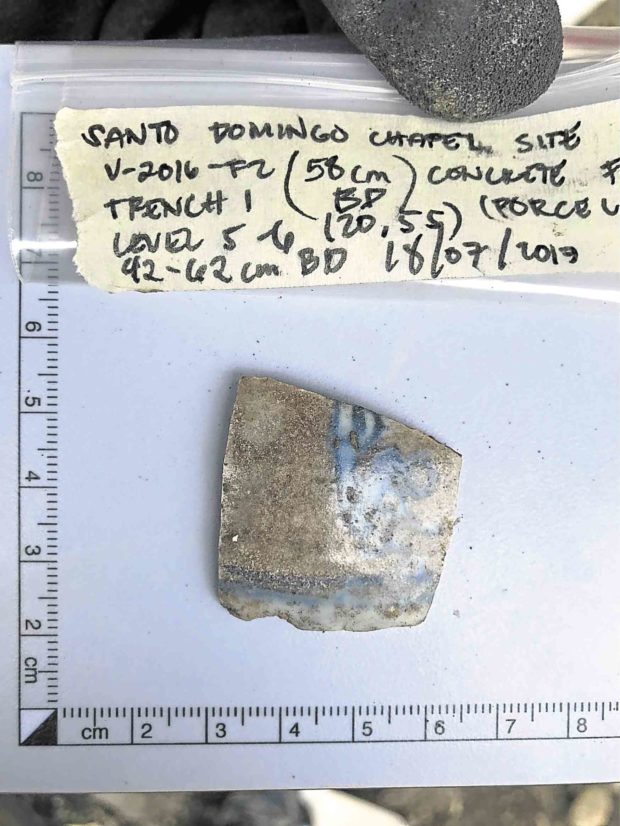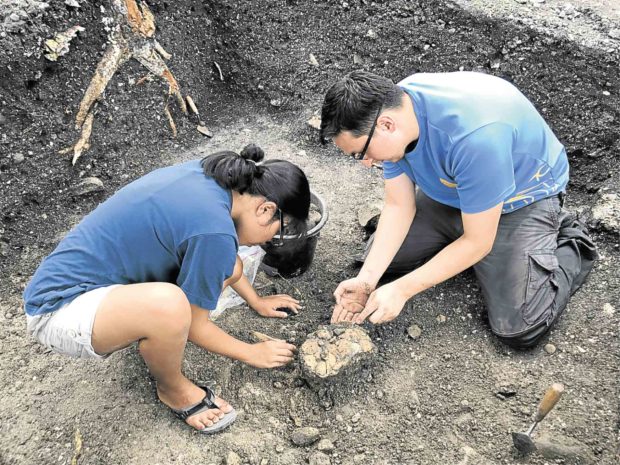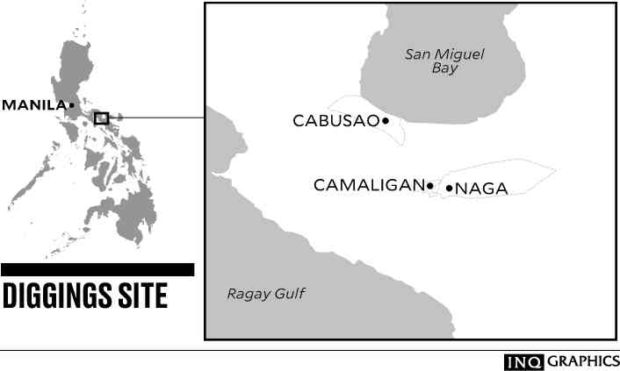1,500-yr-old artifacts found in CamSur

A shard of porcelain jar, believed to have been used by ancient communities, is among the artifacts unearthed.
CAMALIGAN, Camarines Sur—Shards of burial jars found in an ancient graveyard in this town are about 1,500 years old, according to a team of archaeologists.
“It is confirmed that there are pre-Hispanic deposits. The shell midden (heap) is definitely hundreds of years before the Spanish arrival,” said Dr. Stephen Acabado, lead archaeologist and professor at Cotsen Institute of Archaeology of the University of California at Los Angeles (UCLA).
“We hypothesize that Camaligan would be dated to at least 1,500 years ago based on the type of burial jars documented in the town,” Acabado said in an e-mail to the Inquirer.
He said that the layers where these burials were recovered “do not have stoneware, porcelain, and stone and glass beads, which suggest that they predate trade and interaction with foreign traders.”
Predated China contact
Article continues after this advertisementAcabado noted that there were no associated tradeware ceramics. “So, we can assume that the burials predated contact with Chinese, South Asian, Arabic and Southeast Asian traders.”
Article continues after this advertisementHe and fellow archaeologist, Dr. Zandro Villanueva, both from Camarines Sur, are leading a group of archaeology students from UCLA and the University of the Philippines in digging and collecting artifacts in Barangay Sto. Domingo in this town. The project started last year.

Archaeologists unearth artifacts. —PHOTO COURTESY OF BICOL ARCHAEOLOGICAL PROJECT
Under the Bicol Archeological Project, in partnership with the Archdiocese of Caceres and Camarines Sur local government units (LGUs), the archaeological expedition in Camaligan is one of a series of activities that the team will undertake in Bicol to gather evidence of early life and culture of Bicolanos.
“We want to help the local governments’ heritage management for them to have better understanding and awareness of their local history for the development of culture and arts,” Villanueva said.
Acabado urged Camaligan and state agencies to declare the Camaligan poblacion (town center) an important archaeological site.
The municipality should ensure that the site’s integrity is protected from looters and treasure hunters, he said. The archaeological site is about 20 kilometers down the river to the nearest place by the sea, which is the town of Cabusao.
The kilometer-long main road of the poblacion is recorded to have at least a meter-thick deposit of discarded shells, according to Acabado.
“Both sides of the bank of the Bicol River in the area have been reported to have shell midden deposits,” he said.
The project also sought to know the Bicol identity and its roots before the Spanish conquest.
“Our knowledge of the history and culture of the pre-Hispanic people in our country were all based on the writings of the Spanish chroniclers, like the etymology of one place. But we don’t have knowledge of precontact population,” Acabado said.
He stressed the need to gather direct evidence of the population before the Spaniards arrived in the islands that would later be called the Philippines.

WORK AREA Archaeology students from the University of California at Los Angeles and the University of the Philippines work on a dig site in Camaligan, Camarines Sur. —PHOTOS COURTESY OF BICOL ARCHAEOLOGICAL PROJECT
Radiocarbon dating
“The next step for us is to send samples for radiocarbon dating, hopefully in the next few months once we receive permission from the National Museum to send samples back to the United States for dating,” Acabado said.
He said the shell midden and burial jars made the site important in developing a cultural chronology for Bicol. “The site will also provide Philippine archaeology with data for a better understanding of cultural and environmental processes in the region.”
The team was collecting samples of shell midden because these are “sensitive to social, economic and environmental perturbation,” he said.
Indicator of growth
“The shell midden is a proxy indicator of population growth. When you observe the shells deeper into the diggings, they tend to be bigger and growing smaller going up the diggings. It indicates the exploitation of this food resource which means the people then would not wait for the shells to grow bigger to harvest and consume them,” Acabado said.
At least 15 human remains have also been collected, which would be subjected to isotope analysis to determine diet and nutrition.
Acabado said the isotope analysis would provide the team information whether the remains belonged to locals or migrants.
Stingray, pig, deer
He said the team had gathered samples of food the early people in the archaeological site consumed in their lifetime, such as cartilages of shark and stingray, and bones of pig and deer.
It could reconstruct the diet of the people from the shells and determine whether their food was collected locally or whether they were trading with seaside communities, Acabado said.
